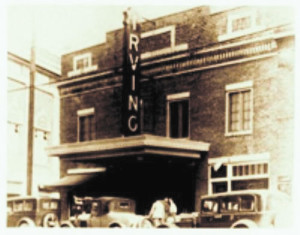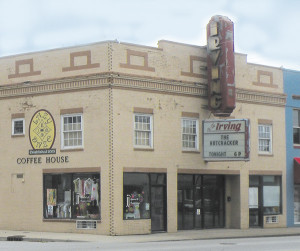One hundred years ago this month, the Irving Theater opened its doors as an entertainment venue. Commissioned by the Idle Hour Amusement Company to be used as a nickelodeon; it was erected by the Guthrie-Thompson Construction Company as a single story building with an Oriental motif. After a neighborhood competition to select a name for the theater, a committee of prominent Irvington citizens announced that the name “the Irving” had been selected.
At the time, theaters being built for the sole purpose of exhibiting films were a rarity. Most theaters, including the ones in downtown Indianapolis, were built for live entertainment such as plays or the very popular vaudeville circuit. Nickelodeons started out in canvas tents or empty storefronts, so the Irving was something of a pioneer.
On Wednesday December 3rd, 1913, Mr. H. L. Whitehead, president of Idle Hour was on hand to officially open the theater. The theater seated 535 and “contained every appliance to make the perfect picture.” The admission price was 10 cents. The theater was not open on Sundays. The Irving exhibited films distributed by the General Film Company, and were generally 15 to 20 minutes in length, although an occasional half hour film was shown. The filmmakers feared that the average viewer just couldn’t sit still long enough for a lengthy 30 minute movie. Within a few years, films would stretch to an epic 59 minutes or even longer.
As the Roaring Twenties progressed, the Irving needed to adapt to the times. Local businessman Charles Walker purchased the theater in 1927 and it underwent some major renovations which enhanced the look and feel of the street corner. A second story was added to the front of the theater to contain a fireproof projection room and two additional rooms. The motif was changed from Oriental to Spanish. About 60 extra feet was added to the rear of the theater and the screen was moved back which increased the seating capacity to over 600. The original lobby was converted to two small retail shops that faced Washington Street. Along Johnson Avenue, three commercial units were added, along with three apartments on the second floor. The idea of the neighborhood theater was just that — most of the patrons usually walked to the theater to attend a film. There was also the bus and trolley lines for transportation, so there was limited parking for automobiles but the majority of customers didn’t own a car.
The movie programs followed a very fairly regular schedule: a feature, and a sub-feature, selected short subjects such as a news reel, a comedy short, perhaps the chapter of a serial, and a cartoon. All in all a showing lasted about two-and-a-half to three hours, On occasion, a fashion show, or even a lecture was conducted at the Irving. Programs usually changed on Fridays and Tuesdays unless the program was very popular. The movies were generally first run “B’s” with westerns, comedies, and detective whodunits being very popular with moviegoers. Kiddie matinees on Saturdays sold lots of popcorn.
The Irving thrived through the Great Depression and the War years. It was a place to go to forget your problems, cheer the good guy, hiss the villain, and laugh at the comedy hijinx. Audiences spent some quality time with Rudolph Valentino, Clara Bow, Lon Chaney, Charlie Chaplin, Greta Garbo, Laurel and Hardy, Tom Mix, Norma Shearer, Clark Gable, the Marx Brothers, Carole Lombard, Jean Harlow, Boris Karloff, Claudette Colbert, John Wayne, Bogy, Bette Davis, Johnny Mack Brown, Cary Grant, Joan Crawford, Fred and Ginger, Katherine Hepburn, Spencer Tracy, Jimmie Cagney, Barbara Stanwyck, Bing Crosby and Bob Hope, Henry Fonda, Gary Cooper, Abbott and Costello, Judy Garland, Van Johnson, Elizabeth Taylor, William Holden, Kirk Douglas, Marlin Brando and the other greats of the Silver Screen.
When television came on the scene in the 1950s, the Irving, like most other neighborhood theater saw a decline in attendance. The Irving underwent more renovation. The auditorium was modernized, and the old canopy was removed and carrera-style glass was added. Double features, 3-D, Technicolor, CinemaScope, and Panavision stereophonic sound all were added to the Irving to keep the box office humming. Parking was not always easy. The Walker family had owned the Irving since 1927 but in 1969 it was sold to some Chicago businessmen. Within a short period of time, the Irving was rechristened the “Festival” Theatre. The Festival started showing so-called adult features, but by 1971 it was showing hardcore XXX films. The Festival seemed to be emblematic of a decline in the neighborhood as several other adult-themed businesses opened along East Washington Street. The Irvington citizens and city officials struggled for 10 years to clean up and revitalize the neighborhood, but shutting down the Festival always remained the focus of their efforts. Finally, in 1979, the Festival was closed.
For the next few years the Theater fell into several hands. It reopened as the Zenon I and showed second run movies for a couple of years. In 1987 some Irvington businessman reopened the theater again as the Irving Theatre to much fanfare. It enjoyed some success as an art house theater, showing independent and foreign films, with an occasional vintage film recalling the theaters past glories. After closing in 1994, the Irving ownership passed through several more hands, with each new owner attempting to find a formula for success with the Irving. Financing problems always seemed to be at the heart of each failed venture. In December 2008, Irvington entrepreneur Dale Harkins acquired the Irving. Dale has so far been successful in revitalizing the Irving as a concert venue for both national touring and local musicians, as well as teaming up with the Ball State and Butler Theater Departments to provide a unique live theater stage for their students to perform. The Irving has hosted appearances by such notables as Marilene Isaacs and Glory-June Greiff as well as other entertaining and informative programs. The Irving has been reborn as an entertainment destination.
Perhaps what has worked best for the Irving is that in its 100 year history, it has always remained a theater. It was never converted to dry cleaners, or a hardware store, or a second hand clothing store as a number of other former neighborhood theaters have. The Irving has remained true to the original intent of the Idle Hour Amusement Company when they opened way back in 1913. It is and remains a neighborhood entertainment palace.





